

August 16, 2022 SmileCon reflects ADA’s core values of diversity, inclusion
“…The Houston metropolitan area is home to the nation’s fourth-largest Hispanic/Latino population at more than 2.7 million people. More than 1.6 million immigrants and 70,000 refugees call the Houston area home, mostly from Hispanic/Latino countries and also Asia and Africa…”
RCC Spotlight: Amber Lovatos, the Latina RDH
“…As a first-generation Mexican-American growing up in a low-income home, there was no access to dental care. Amber struggled to speak English and barely graduated from high school. As a teen mom, she suffered from depression. She worked as a dental assistant, but after leaving an abusive marriage, she realized that dental assisting wasn’t enough to provide for her and her two young sons. Amber realized that she needed to get ahead in life, and when her friend Maxine Cordova suggested they both become dental hygienists, it seemed like a path to success..”
https://www.rdhmag.com/career-profession/article/14233012/rcc-spotlight-amber-lovatos-the-latina-rdh
Volunteers step in to keep asylum seekers healthy on border
“TIJUANA, Mexico — When the Honduran boy complained of a toothache, Dr. Psyche Calderon asked the obvious question: “When did the pain start?”
The answer broke her heart.”When La Mara broke all my teeth and killed all my family,” the 14-year-old said.
He said little else about the attack by the infamous Central American gang, La Mara Salvatrucha. Just: “I was the only one that survived.”
Calderon is not a therapist, nor a lawyer or a dentist. She is a general practitioner volunteering her time to provide care for Central Americans stuck in Mexico while they try to obtain asylum in the United States. There was little she could do for this teenager…”
Link to article
Race, income may impact U.S. oral cancer screening rates
“…Only about 1 in 3 U.S. adults say a dentist has ever examined them for oral cancer – and most of those who remember getting such exams are non-Hispanic whites, a new study suggests.
The American Dental Association says dentists should routinely look for oral cancer. But the study, published in the American Journal of Preventive Medicine, found that screening rates were low overall and that racial and ethnic minorities, and people with lower income and education, were less likely to report receiving oral cancer screening during a clinic visit.
“We promise health care to all, but some sections report not getting the quality others do,” lead author Avni Gupta from the Center for Surgery and Public Health at Brigham and Women’s Hospital in Boston told Reuters Health by telephone…”
Link to article
Mexican American Proarchive: Annual Report on Mexican American Professionals
News from the census American Community Survey is generally good for the 2015 year. Mexican American college enrollment was up from 18.7% to 18.9% in the 2014 and 2015 years. Graduate or professional degree attainment was also up from 2.9% to 3.0%. The number of bachelor’s degrees granted to Mexican American students rose from 7.6% in 2014 to 7.8% in 2015.


In spite of these gains, Mexican Americans still remain at the bottom of the ladder when it comes to earning a bachelor’s degree. Even after broadening the group to Latinos or Hispanics, this group still lags behind. According to the Pew Hispanic Center: “As of 2014, among Hispanics ages 25 to 29, just 15% of Hispanics have a bachelor’s degree or higher. By comparison, among the same age group, about 41% of whites have a bachelor’s degree or higher (as do 22% of blacks and 63% of Asians).” Pew reports that the main reasons for this low graduation rate is that Hispanics are less likely “to enroll in a four-year college, attend an academically selective college and enroll full-time.”
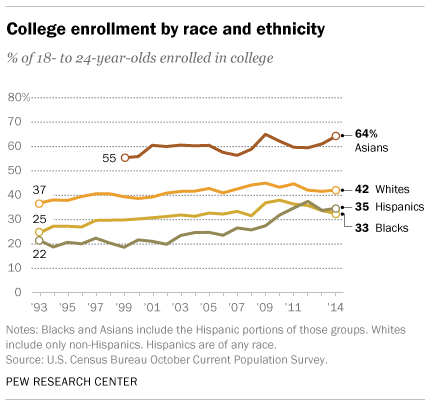
Also in the good news column, the University of California will continue to push for a greater number of underrepresented minorities; namely, Chicano/Latino students whose resident freshmen numbers rose from 2.7% to 32.3% of admitted California freshmen. In other good news, the proportion of Chicano/Latino students transferring from community colleges increased to 29.3% from 26.8% for 2015.
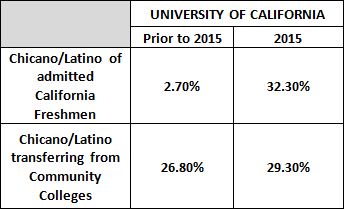
Occupations, including those in management, business, science, and art, fared better for Mexican Americans. The number of Mexican Americans filling these occupations rose from 17.4% in 2014 to 17.5% in 2015.

The total number of Hispanics filling these occupations was 16.1% in 2015, a bit lower than Mexican Americans specifically.
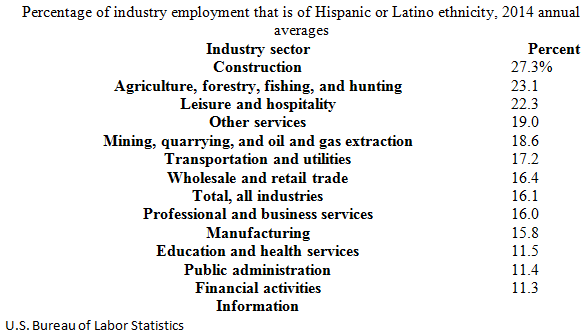
The report shows that industrial employment for Mexican Americans remained the same for 2014 and 2015 at 10.2%.
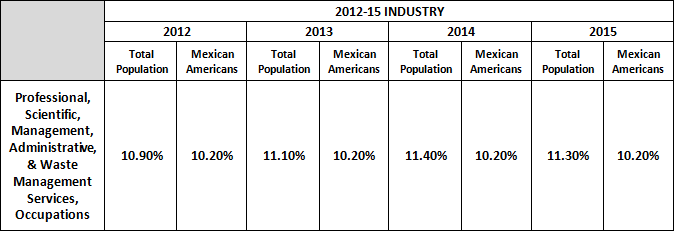
The figures for Hispanic or Latino employment for 2015 and 2016 show a healthy increase.
According to the Pew Hispanic center, “Construction, professional and business services, health services, financial services and food services…showed healthy gains.” Most of the jobs gained by native-born Hispanic workers were in manufacturing, mostly durable goods (82,000 Hispanic workers in this industry), followed by wholesale and retail trade (79,000), publishing, broadcasting, communication and information services (55,000), and construction (54,000).
Foreign-born Hispanics had the most job gains in construction (417,000), followed by business and professional services (179,000). Together, those two industries accounted for almost three-quarters (74%) of all jobs gained by foreign-born Latinos between 2005 and 2006.
The business and professional services sector, which ranges from management and technical services to janitorial, landscaping, and waste management services, is also a key employer for non-Hispanic workers. Of the total increase in employment in 2005-06, non-Hispanic workers accounted for 410,000 employees in the industry, native-born workers 327,000, and foreign-born workers 83,000.
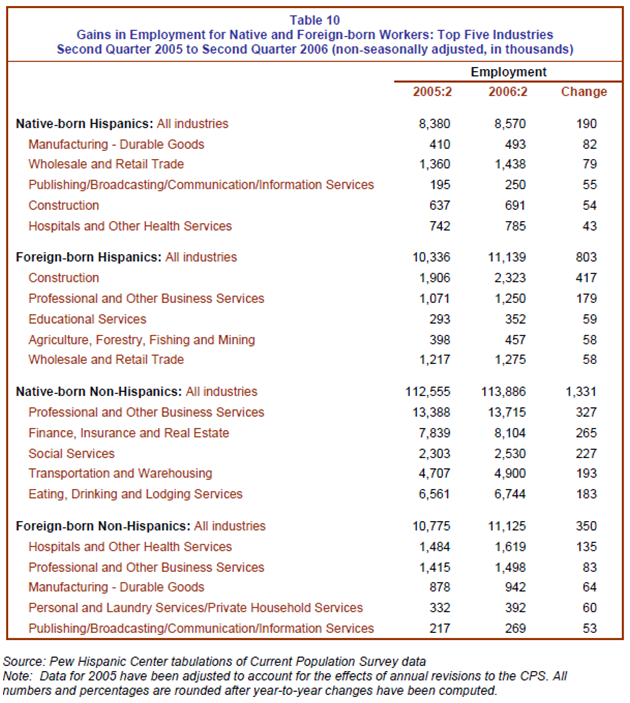
Sources
- Census Bureau, Selected Population Profile in the United States: 2015
- Pew Research Center
- University of California
- Bureau of Labor Statistics
College’s Hispanic Student Dental Association Chapter Named National Chapter of the Year
June, 21 2016
The University of Illinois at Chicago (UIC) College of Dentistry’s Hispanic Student Dental Association (HSDA) Chapter was named the Hispanic Dental Association’s (HDA) 2016 National Student Chapter of the Year at the HDA’s recent Annual Meeting in Washington, DC. This award recognizes the chapter for outstanding efforts to provide service, education, advocacy and leadership in Hispanic oral health.
Selected by a committee consisting of HDA National Office staff members and invited jurors, the chapter stood out among affiliate dental student chapters across the nation…
Link to article
Racial Disparities in Orthodontic Care for Medicaid -Enrolled Children in Washington
JM Merritt – 2015
… indicative of a class II malocclusion. Whites, Blacks and Mexican Americans had a varying
prevalence of 57.6%, 64.4%, and 66.4% respectively for >2mm overjet.10 Class III malocclusion …
Blacks and Mexican Americans. Racial Disparities in Orthodontic Use for Children …
Link to thesis
Qualitative description of dental hygiene practices within oral health and dental care perspectives of Mexican-American adults and teenagers
G Maupome, O Aguirre‐Zero, C Westerhold – Journal of Public Health Dentistry, 2014
… of things, discontinuous implementation of treatment plans and of professional recommendations
fitted with … would be accrued by adding the perspectives of dental professionals to interpret … Mexican
American mothers’ initiation and understanding of home oral hygiene for young …
Link to abstract
MEXICAN American youth TEENAGERS — Health & hygiene TOBACCO habit
JA Pesa
… Mexican-American adolescents appear to be at risk for participating in unhealthy behaviors on
par with the majority adolescent population. It is important that efforts be made on the part of
involved professionals to better understand the special needs and cultural differences that …
Link to study
Maternal Beliefs and Motivations for First Dental Visit by Low-income Mexican American Children in California
KS Hoeft, JC Barker… – Pediatric Dentistry, 2011
… by 3-years- old.8 These late visits may be in part due to financial barriers to access and dental
professionals’ reluctance to … among the highest rates of early childhood caries (ECC), even when
controlling for other variables such as income.16 Mexican American school children …
Link to abstract


